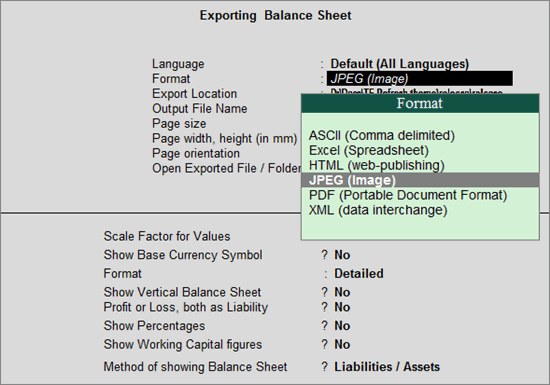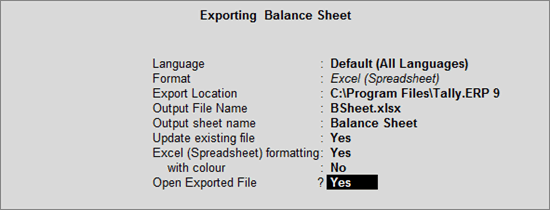
You can export data or report from Tally.ERP 9 in any one of the standard available formats. You can select the required format before exporting the data and based on the format selected you need to specify the resolution, page size and formatting.
You can also export the data in non-editable formats such as JPEG and PDF formats. The JPEG format has dual facility, where the user can store the file in printable format or as an image.

By selecting the ASCII (Comma Delimited) format, you can export all the reports or data from Tally.ERP 9. The data exported is converted to plain text separated with commas and stored in a file with the extension .txt. This file format is widely used for sending data using e-mail.

You can export data and reports generated in Tally.ERP 9 to Excel by selecting the Excel (Spreadsheet) format. The data is put in columns and the file is saved with the extension .xls. You can also export data with formatting and background colour as it appears in Tally.ERP 9. You can set the formatting and background colour in the Export Report screen. The Excel file can be sent as an attachment and also used to generate graphs for better presentation.

Note: Export to Excel is compatible with Microsoft Office 97 or higher versions only.
Tally.ERP 9 exports the data faster when Excel (Spreadsheet) Formatting is set to No.
On selecting the HTML (Web Publishing) format, Tally.ERP 9 exports the data in HTML format retaining the colours and formatting. The file name has an extension .htm. It can be sent as an attachment and read using an internet browser. It is recommended that you choose a higher resolution for better quality output.

On selecting this format the specified report is exported as an image file which is stored with an extension .jpg in the specified folder. The image file generated is non-editable, platform independent and supports the highest level of compression. You need to specify the paper orientation and paper size. If you are opting to store the report on a User defined or customised paper size, you need to specify the page width and height in millimeters. This image file can be mailed as an attachment to a recipient, viewed using an image viewer and printed.

WHen you select PDF ad the format for export, the report is converted to a PDF document which is independent of the application software, hardware and operating system. This document can be viewed using the Adobe Acrobat Reader commonly known as the PDF Reader. On exporting the data using PDF format, the file is stored in the specified location and assigned the extension .pdf. While configuring the system to export data to PDF it is necessary for you to specify the paper orientation and paper size. On opting to store the report with User defined or customised paper dimensions, you are required to specify the page width and height in millimeters. This PDF file can be mailed as an attachment to the desired recipient and viewed using the Adobe Acrobat reader or PDF reader.

Extensible Markup Language (XML) is an extension of HTML. Using XML, data can be imported by other systems. An XML file from Tally.ERP 9 has an XML envelope and formatted with XML tags to enable import into other systems. The destination system requires re-formatting of XSLT (XML Style Sheets) based on the inherent style used in Tally.ERP 9 before importing the data. When two systems are running different versions of Tally.ERP 9, XML data can be directly imported using the import menu option, without re-formatting.

Note: Data stored in Tally 7.2 can be exported to Tally 9 or Tally.ERP 9. However data stored in Tally 9 or Tally.ERP cannot be exported to Tally 7.2.
The exported files of any of the selected format are stored in C:\Tally.ERP 9 for Windows XP and C:\Program Files\Tally.ERP9 for Windows 7 operating system.